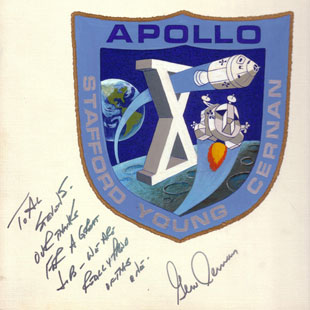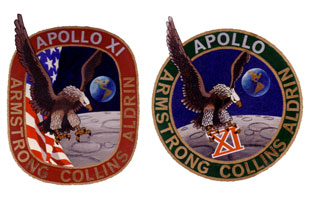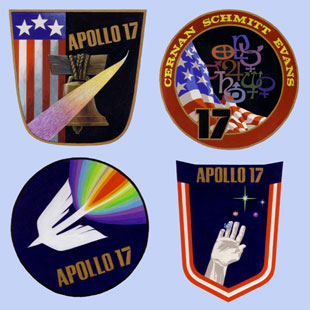May 20, 2008 — Sometimes you have to be lucky as a space flight historian. A friend, Noah Bradley, purchased on eBay recently a collection of sketches, paintings and documents that had belonged to one 'Allen A. Stevens'. That name will probably not immediately mean much to space enthusiasts, but his artwork is widely recognized.
Born on June 16, 1915 in Colorado Springs, Colorado, Al Stevens worked during the 1960s and 70s as a graphic designer for the Space Division of Rockwell International in California. He retired in 1978 and, after suffering from several strokes over a period of 13 years, he died on May 21, 1994 in Orange, California.
The box that Noah bought contained Stevens' artistic legacy. His belongings included various original designs for the emblems from half a dozen Apollo missions.
More importantly, the papers that were included provided proof that Stevens was the artist behind the final designs for the Apollo 1, Apollo 7, Apollo 9 and Apollo 10 mission patches. The designer for these emblems had not been previously widely publicized.
Among the many tasks that astronauts face when they are preparing for a spaceflight is the relatively minor duty of designing a patch to represent the flight. Since Gemini 5 in 1965 this has become standard practice and the mission patches have become icons of the space age.
The tradition of designing a patch had its roots in the military and as the majority of the early astronaut corps was comprised of career military pilots, it was only natural that they carried this custom over into the space program.
Although NASA management was initially not happy with the idea, the tradition of the mission patch has become an important aspect of today's space missions, with each shuttle crew designing a unique patch to symbolize their mission's goal(s).
As with so many things, that process is now largely done using computers. In the early days however, the designs were completely painted by hand, allowing us, 40 years later, to give Al Stevens credit for his contributions to the Apollo program.
Designs for Apollo

Two preliminary versions of the Apollo 1 patch, followed by the final design chosen by the crew. (Click to enlarge.) |
Stevens' work was originally intended for public relation brochures for Rockwell, builder of the Apollo spacecraft.
In 1966 however, he came to work with the crew for the first manned Apollo mission, Gus Grissom, Ed White and Roger Chaffee, designing their mission patch. In an October 1968 interview for a local California newspaper, Stevens was quoted as saying that he "just sort of fell into it," and that he didn't work very close with Grissom's crew. "They were so busy with other things, I only spoke with them two or three times," he said.
After the Apollo 1 crew died in a pad fire in January 1967, Stevens was asked again for help in designing a patch for the next mission in line, Apollo 7. One of the crew, Walt Cunningham, wrote of their emblem's design in his book, "The All-American Boys". "It was our original intention to emphasize the first manned Apollo (Gus Grissom's flight) and the recovery from the fire on the pad aspects as well. We considered a spacecraft rising from a ball of fire and calling it the Phoenix."
Some of the designs that Stevens made indeed showed the phoenix, the Phoenician mythical firebird, in addition to the flight number and names of the crew members, but as Cunningham wrote, the patch "was subject to NASA approval and we abandoned the phoenix theme, feeling it would be rejected as in bad taste."



Stevens' early designs for Apollo 7, featuring the phoenix rising out of the ashes of the Apollo 1 fire. The final patch, lower right. |
Cunningham asked Stevens to concentrate on a circle for the Earth and an ellipse for orbit. Several more designs were submitted before the crew settled on a final version, which was then approved by agency officials.
Stevens said at the time that the problems involved in such design work were interesting in themselves. Crew members often had their own definite ideas about the patch, he said, while others hadn't the faintest notion. He found it easier to come up with a design when the crew could convey precise ideas.
The interview with Stevens also contained a clue as to why he might not be widely known today as other patch artists. He was described as a soft-spoken man, who was very modest about his contributions. "Just don't flower it up too much," he said. "It's part of my job, that's all."
Assignments reshuffled
After Apollo 7, which flew in October 1968, Stevens also submitted designs for the next two planned missions. In the original flight sequence, Apollo 8 would be flown by Jim McDivitt, Dave Scott and Rusty Schweickart to test the lunar module in Earth orbit in late 1968. This would be followed in early 1969 by Apollo 9, manned by Frank Borman, Mike Collins and Bill Anders, who would repeat these tests in high Earth orbit.
Stevens began designs for both missions' patches, but a complicated reshuffling of flight assignments interfered with his work. In July 1968, Apollo 9 pilot Mike Collins had to undergo surgery and was replaced by his backup, Jim Lovell.
Then on August 11, the decision was made to switch missions 8 and 9 because of delays in delivering the first lunar module. Borman, Lovell and Anders thus became the Apollo 8 crew, which flew into history as they orbited the Moon in December 1968. The first lunar module test was bumped to Apollo 9.

The theme of the three horses, which Stevens apparently also considered for Apollo 7, inspired him for the Apollo 8 design. This one was rejected when Jim Lovell came up with his own sketch. It is interesting to note that three horses made another appearance in the patch for Lovell's next mission, Apollo 13. |
Lovell has stated on several occasions that he made the first sketch for the eventual Apollo 8 emblem in the back seat of a T-38 flown by Frank Borman from Los Angeles to Houston on August 12, 1968, the day after they had heard they would go to the Moon. He says that his sketch so accurately reflected the mission that no other designs were ever considered.
It is not known to what extent Stevens was involved in the design of the Apollo 8 patch that we know today. It is possible that he made the final version, based on Lovell's sketch. The patch shares the general shape of the Apollo command module with a number of designs Stevens had made earlier for Apollo 7.

Two stages in the design for the Apollo 9 patch, followed by the final version. The one on the left was made before August 1968, when the mission was still called Apollo 8. Schweickart's name was misspelled in the first two. |
Stevens however, did create the final art for the Apollo 9 patch. Among his papers, there is also an early design from when the mission was still called Apollo 8 that was apparently rejected by the crew.
Another version shows what is essentially the flown form, but was also rejected because the lunar module is facing the wrong way and Schweickart's name was misspelled. So Stevens had to paint a new revision, which became the emblem the crew wore on their spacesuits during the mission.
Apollo 10 and more

Next to fly was Apollo 10 and again Stevens was asked by the crew to design an insignia. Among his documents were several preliminary designs, as well as the painting for the approved patch with a hand-written inscription by Gene Cernan, thanking Stevens "for a great job - we are really proud of this one."
The archive also included several versions for an Apollo 11 patch. It is not quite clear what role Stevens played in the design of this famous mission patch. In "Carrying The Fire," astronaut Mike Collins described how Lovell, as backup commander for the flight, came up with the idea of an American eagle.
After finding a suitable image in a National Geographic book on birds, Collins traced the eagle on to a piece of tissue paper and used that as a basis for his design of the mission patch. Additional details can be found in Dick Lattimer's 1985 book, "All We Did Was Fly To The Moon," wherein Collins was quoted identifying the artist. "Stan Jacobson in Houston assigned an artist on his staff, James R. Cooper, to finalize the design for us."
The two finished Stevens' Apollo 11 paintings that were found also show the eagle, with one clutching the Roman numeral 'XI'. Collins wrote that "after trying XI and 11, we settled on the latter and put Apollo 11 around the top."

These two early versions of the Apollo 11 patch suggest that Al Stevens participated in the design, but his exact role is unclear. |
It is possible that Stevens did help during the early phases of the design process. This is also suggested by both designs as they feature the names of the crew, although Collins wrote that the crew wanted to keep their three names off the patch because they felt that they represented everyone who had worked toward a landing.
It is interesting, however, that Stevens left behind a sketch of the eagle, clutching an olive branch, exactly as it appears in the final version of the Apollo 11 emblem. So if Collins is correct about the name of the artist who finalized the design, there is a good possibility that Stevens did contribute significantly to the early design. This would seem only natural, as he was the man who had designed practically all the Apollo patches up to that point.
From his papers, it also appears that Stevens was at it again for Apollo 12, as there were two different designs featuring the clipper ship. One of these had the names Conrad, Gordon and Bean. Alan Bean has said that the Apollo 12 patch was created by the crew with the help of about 10 other people around the contractor area at the Cape.
An unidentified artist who was working at Patrick Air Force Base made the final version. So again it appears that Stevens was to some extent involved in the design but his exact role was and will probably always remain unclear.
Work for Apollo 17
The documents and artwork that Stevens left behind about his work on Apollo 17 provide the best look at how the process of designing a crew patch worked, though it is known that the patch was eventually created by artist Robert McCall.
It began with a memo by mission commander Gene Cernan, dated March 3, 1972, outlining his thoughts on what the crew wanted to see in the design. "We are soliciting ideas from several sources with the hope of capturing the uniqueness of our thoughts in the creation of our patch. Our desire is that Apollo 17 symbolize not the end of an era, but rather the culmination of the beginning of mankind's greatest achievements in his history - achievements which only have as their bounds the infinity of space and time - symbolization that man's seemingly impossible dreams can become limitless realities.
"We would like to recognize the historical foundation upon which the thoughts of the future are based - and, so as never to forget, we also hope to pay tribute to the Apollo program and our nation, its people and its heritage, which has made these accomplishments all possible," Cernan's memo continued. "The symbolism which captures these ideas sounds sophisticated and complicated to create. We hope it is not, because it is our desire to capture our theme with simplicity."
The astronauts did not contact the artists directly. Cernan's description was sent to the art departments at the various NASA centers as well as the various Apollo contractors.
And so the memo also ended up on the desk of Tom Short, Rockwell's vice president for field operations. On March 6, Short passed it on to the head of the graphics department at the space division, where Stevens worked, with the following note: "Gene Cernan provided the enclosed description of what the Apollo 17 crew intends to be a basis for an artist's conception for their patch. They are currently talking to several different designers, including Bob McCall, who is the man that designed the US stamp commemorating the space program."
"Gene asked me if I could get some of our more creative people to provide ideas and/or conceptions based on his word description. I would appreciate it very much if you would have your guys take a crack at it."
It is interesting that McCall is mentioned as one of the participating designers, but Stevens did not take this as a sign that he didn't have a chance. In the weeks that followed he produced a large number of sketches, playing with several shapes and themes. These in turn led to a number of preliminary designs, in which the American flag and eagle were recurring subjects.

These are the four designs that Stevens submitted for Apollo 17, but despite his work the crew chose a design by Robert McCall. |
Finally, he settled on four final designs which were submitted for approval. They were accompanied by written descriptions, explaining the thoughts behind them. One showed the Liberty Bell as "a graphic symbol that characterizes the American heritage in almost all facets," as Stevens wrote. "The finding of a new world; the colonization of a new world, America; establishing of the freedoms and the dreams that good men aspire to."
Another design featured the astronomical symbols for the solar system, "symbolizing man's dreams of expanding knowledge and quest." A third showed "mankind's hand reaching for the stars, symbolizing man's quests for truth, knowledge, and the solution to his current and future problems." By now Stevens was a veteran at this kind of work and his art was filled with symbolism, as had been requested by Cernan in his initial memo.
When all the designs were submitted, the crew chose the one that they thought best represented their mission. It is unknown how that decision was communicated to the participating artists, but it was probably done by way of a memo. The final version of the Apollo 17 emblem, painted by McCall, was released to the media on September 8, 1972, so the whole process took roughly six months from start to finish.
Skylab and Shuttle
During that same timeframe, Stevens also submitted a number of designs for the second manned Skylab flight with astronauts Bean, Owen Garriott and Jack Lousma. The emblem for this flight was released in February 1972, even before Stevens started working on the Apollo 17 design, so most of his work must have been done in late 1971. Though his designs contain several themes that are also present in the final version of this insignia (the human figure, the Sun and the Earth), it is not known whether the final patch was actually painted by Stevens.
In "All We Did Was Fly To The Moon," Lousma says that the final version was made by an unidentified artist at McDonnell Douglas in Huntington Beach. However, in among Stevens' collection was a certificate, signed by the Skylab II crew, thanking Stevens for his "constant endeavor toward excellence and outstanding contributions in support of the second manned Skylab mission."
Stevens ultimately also created several designs for a space shuttle mission patch. This must have been after he retired from Rockwell, though. Looking at the designs, they were probably for a Spacelab mission, perhaps for STS-9/Spacelab-1, because one of the crew members, Owen Garriott, might have remembered that Stevens also contributed to his Skylab mission emblem.
Legacy of Al Stevens
Today, space patches are popular among collectors and there are several books and websites detailing their origin and history. But the name Al Stevens isn't mentioned. If it hadn't been for this box containing his artwork, he would probably still be unknown to the larger space community.
Among the icons of the space age, Stevens' patches are now the classics. He should be recognized for his work and now finally be able to receive the credit he deserves.
A version of this article was published concurrently in the British Interplanetary Society's Spaceflight magazine.
The author thanks Noah Bradley and Larry McGlynn for their help, encouragement and use of their examples of Al Stevens' artwork.
